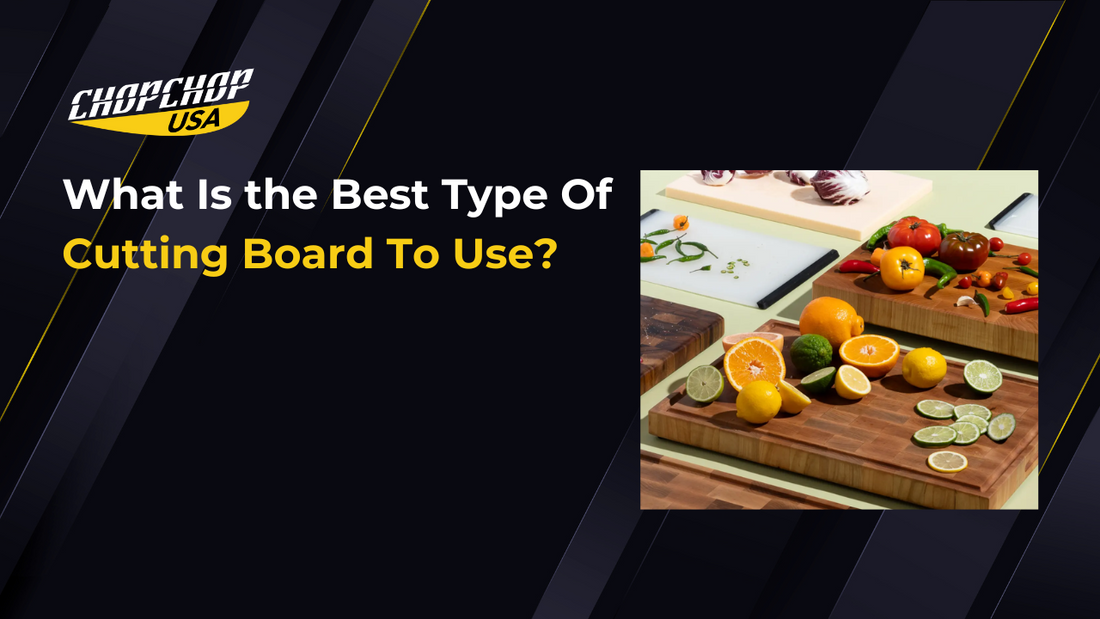Choosing the best type of cutting board is essential for food safety, durability, and maintaining the longevity of your knives. With so many materials available, selecting the right cutting board can feel overwhelming. This guide will help you understand the key factors to consider when choosing a cutting board and determine the best type of cutting board to use for various kitchen needs.
Why Choosing the Right Cutting Board Matters
A cutting board is a fundamental kitchen tool, but not all cutting boards are created equal. The right cutting board enhances hygiene, prevents cross-contamination, extends the life of your knives, and provides durability for long-term use. Selecting the best type of cutting board to use ensures you get the most out of your cooking experience while maintaining a clean and safe kitchen environment.
Factors to Consider When Choosing a Cutting Board

When selecting the best type of cutting board, consider the following factors:
1. Material
The material of a cutting board affects its performance and durability. The most common materials include:
- Wood cutting board: Classic and knife-friendly, but requires regular maintenance.
- Plastic cutting board: Affordable and easy to clean but can develop deep grooves.
- Bamboo cutting board: Eco-friendly and durable but harder on knives.
- Glass cutting board: Non-porous and hygienic but can dull knives quickly.
- Composite cutting board: A blend of materials designed for durability and ease of cleaning.
- Metal (Titanium vs Stainless Steel cutting board): Extremely durable, resistant to bacteria. They are considered as one of the two Best Cutting Board Material For Your Health 2025.
2. Knife-Friendliness
Some cutting boards are gentler on knives than others. For example, wooden cutting boards help maintain sharp edges, while glass, metal, and certain plastics can wear down blades faster. The best type of cutting board will ensure your knife stays sharp for longer periods, reducing the frequency of sharpening or replacing your knives.
3. Hygiene & Maintenance
A good cutting board should be easy to clean and resistant to bacteria. Wooden and bamboo boards require regular oiling, while plastic boards are dishwasher-safe. Some boards come with antimicrobial properties for added protection. Titanium and stainless steel boards from ChopChop USA offer excellent resistance to bacterial growth and are effortless to clean.
4. Durability & Longevity
The best type of cutting board should withstand frequent use without warping or cracking. Hardwood boards last longer but need proper care, while plastic boards may need replacement over time. Metal boards, such as those from ChopChop USA, are virtually indestructible, making them a great long-term investment.
5. Intended Use
Different cutting boards serve various purposes. Using separate boards for meats, vegetables, and bread helps prevent cross-contamination. Choosing the best type of cutting board for meat ensures safer food preparation. For example, metal boards are ideal for heavy-duty chopping, while wood and bamboo are better suited for slicing and serving.
Best Type of Cutting Boards by Material
| Material | Pros | Cons | Best For |
|---|---|---|---|
| Wood | Knife-friendly, durable, naturally antimicrobial | Requires maintenance, absorbs odors | General food prep, chopping vegetables, slicing bread |
| Plastic | Affordable, lightweight, dishwasher-safe | Develops deep grooves, less durable | Raw meats and seafood |
| Bamboo | Sustainable, durable, naturally resistant to bacteria | Tough on knives, needs occasional oiling | Everyday meal prep, slicing fruits, vegetables |
| Glass | Non-porous, stain-resistant, hygienic | Dulls knives, slippery, prone to breaking | Decorative use, serving platters |
| Composite | Durable, heat-resistant, easy to clean | Can be heavy, may wear down knives | Heavy-duty chopping, professional kitchens |
| Metal (Titanium/Stainless Steel) | Extremely durable, bacteria-resistant, easy to clean | Hard on knives, expensive | Heavy-duty chopping, professional kitchens, raw meats |
Best Type of Cutting Boards for Different Uses
Best Type of Cutting Board for Meat

When handling raw meat, hygiene and easy cleaning are top priorities. The best type of cutting board for meat is a plastic or metal board because they are non-porous, dishwasher-safe, and resistant to deep knife cuts where bacteria can hide.
Many professional chefs use color-coded plastic boards to separate raw meat from other food groups, reducing the risk of cross-contamination. For those looking for a premium, long-lasting option, ChopChop USA offers stainless steel and titanium cutting boards that resist bacteria and are easy to clean.
Best Type of Cutting Board for Vegetables

For chopping vegetables, the best type of cutting board to use is a wooden or bamboo board. These materials provide a smooth surface that won’t damage your knife’s edge, allowing for precise cuts.
Additionally, wooden cutting boards have natural antimicrobial properties that help reduce bacterial growth. If you frequently chop juicy vegetables like tomatoes, consider a board with a juice groove to prevent spills.
Best Type of Cutting Board for Bread

Bread requires a stable surface that won’t crush its soft texture. The best type of cutting board for bread is a wooden board, which provides a firm but gentle surface for slicing. Some wooden boards even come with built-in crumb catchers, making cleanup easier.
Best Type of Cutting Board for Fish
Fish can leave behind strong odors, so the best type of cutting board to use for fish is a plastic, metal, or composite board. These materials are non-porous and won’t absorb smells, ensuring your board stays fresh. ChopChop USA’s stainless steel cutting boards are an excellent choice for fish preparation, as they are highly resistant to bacterial contamination and odor retention.
Best Type of Cutting Board for Cheese and Charcuterie

For serving cheese, meats, and appetizers, the best type of cutting board is a high-quality wooden or bamboo board. These materials enhance presentation while providing a sturdy surface for slicing and arranging food.
Best Type of Cutting Board for Everyday Use

If you’re looking for a versatile board for daily meal prep, a composite or bamboo board is an excellent choice. They offer durability, knife-friendliness, and easy maintenance, making them ideal for all-purpose kitchen tasks.
Which Cutting Board Is the Best Overall?
The best type of cutting board depends on your needs. For general use, a high-quality wooden board offers durability, knife-friendliness, and aesthetic appeal. If hygiene and maintenance are top concerns, plastic boards are practical for raw meats and easy cleaning.
For those looking for an ultra-durable option, ChopChop USA offers titanium and stainless steel cutting boards. These boards are highly resistant to scratches, bacteria, and warping, making them an excellent choice for professional chefs and home cooks who want a long-lasting solution. However, they may not be as knife-friendly as wood or bamboo.
Where to Buy the Best Cutting Boards
You can find the best type of cutting board at:
- Online retailers: Amazon, Williams Sonoma, and Sur La Table offer a variety of options.
- Kitchen supply stores: Specialty shops carry high-end and professional-grade boards.
- Supermarkets: Many grocery stores sell affordable plastic and bamboo cutting boards.
- Local artisans: Handcrafted wooden cutting boards are available from small businesses and craft fairs.
- ChopChop USA: Specializes in premium titanium and stainless steel cutting boards for superior durability and hygiene.
Conclusion
Finding the best type of cutting board to use is crucial for maintaining food safety, durability, and knife longevity. Whether you need the best type of cutting board for meat, vegetables, or general food prep, considering factors like material, hygiene, and intended use will help you make the best choice. Happy chopping!
If you have any questions about ChopChop USA's products or promotions, please feel free to contact us at support@chopchopusa.com. Our dedicated team is available 24/7 and always happy to assist you.




